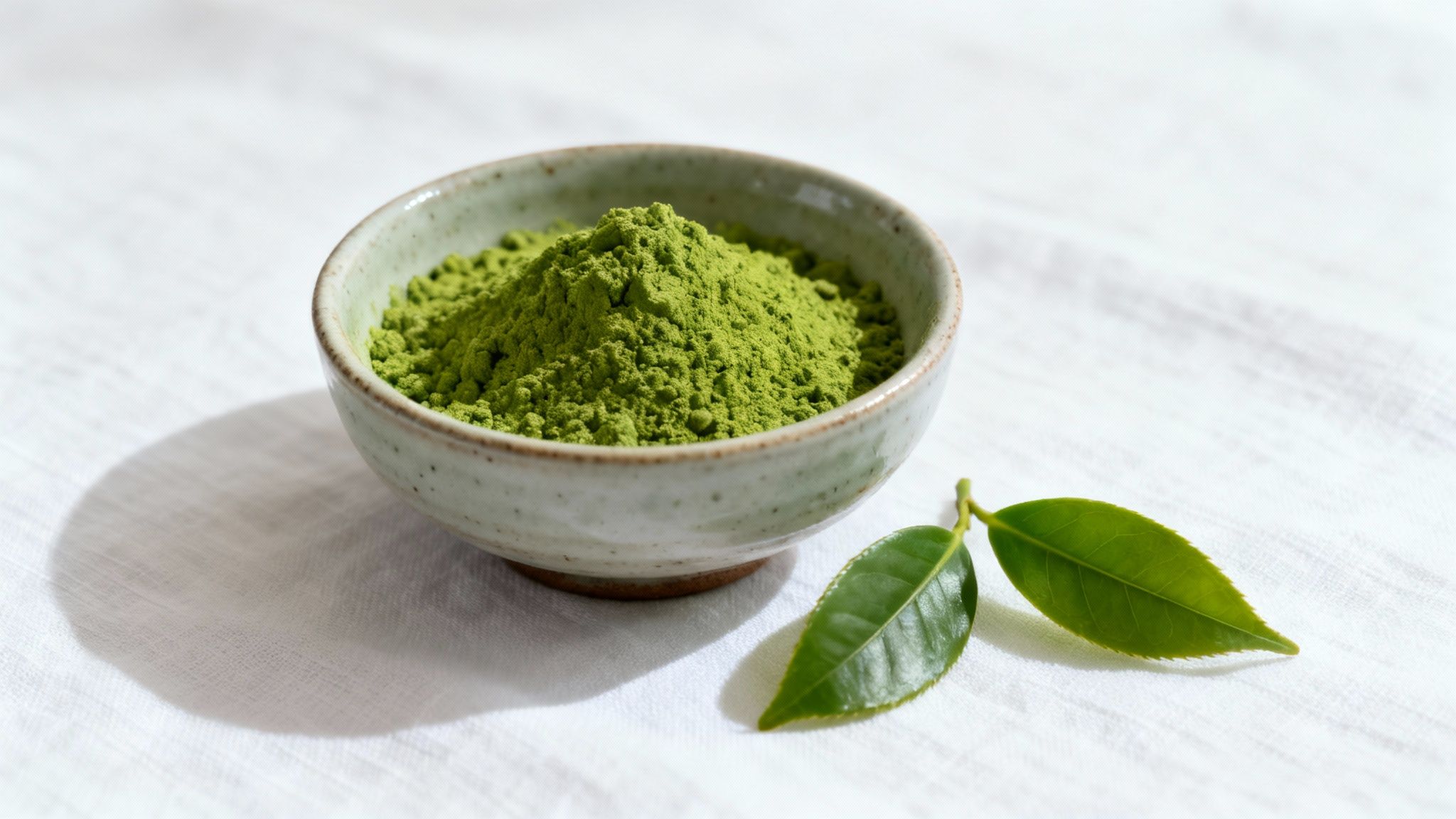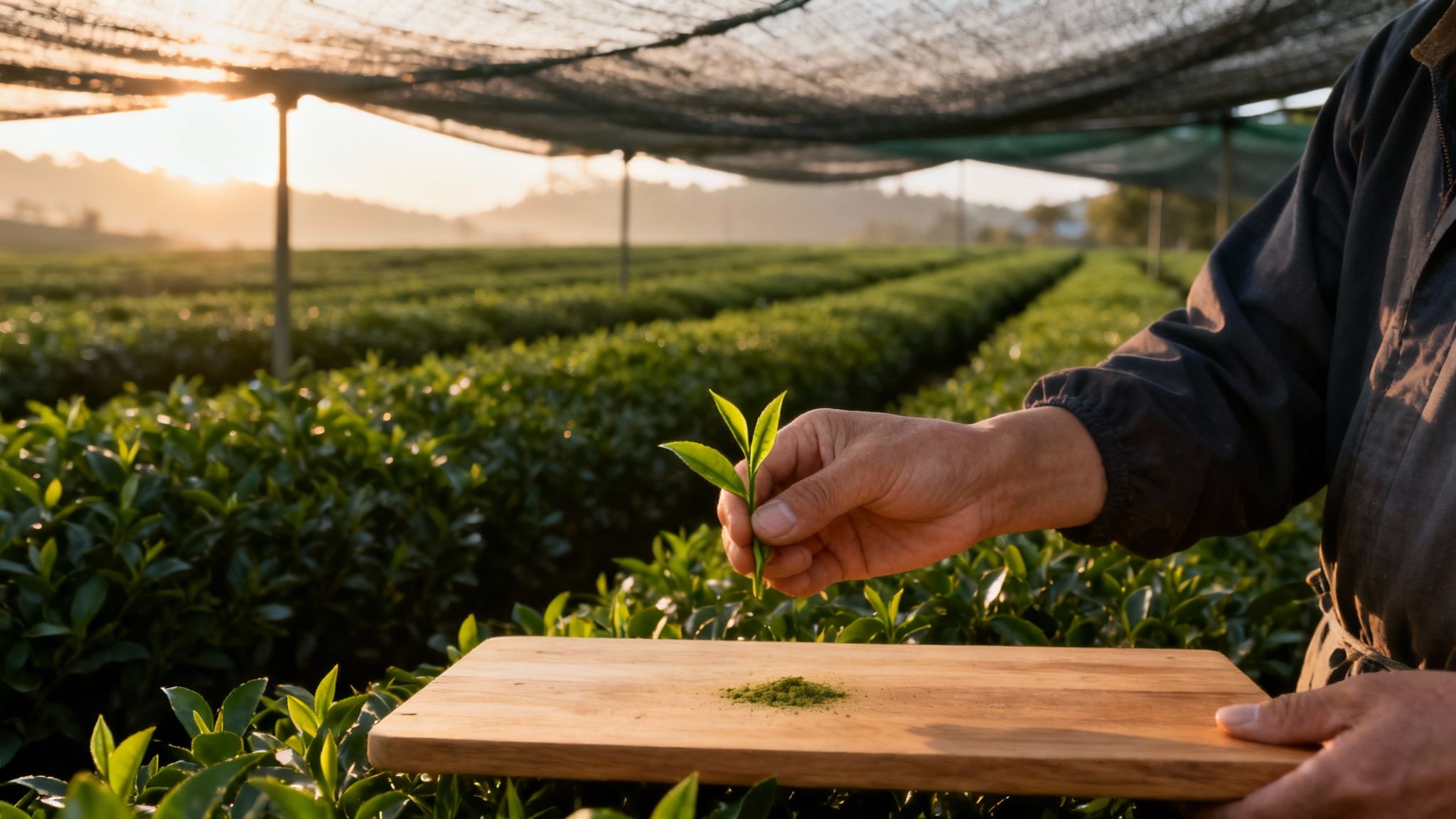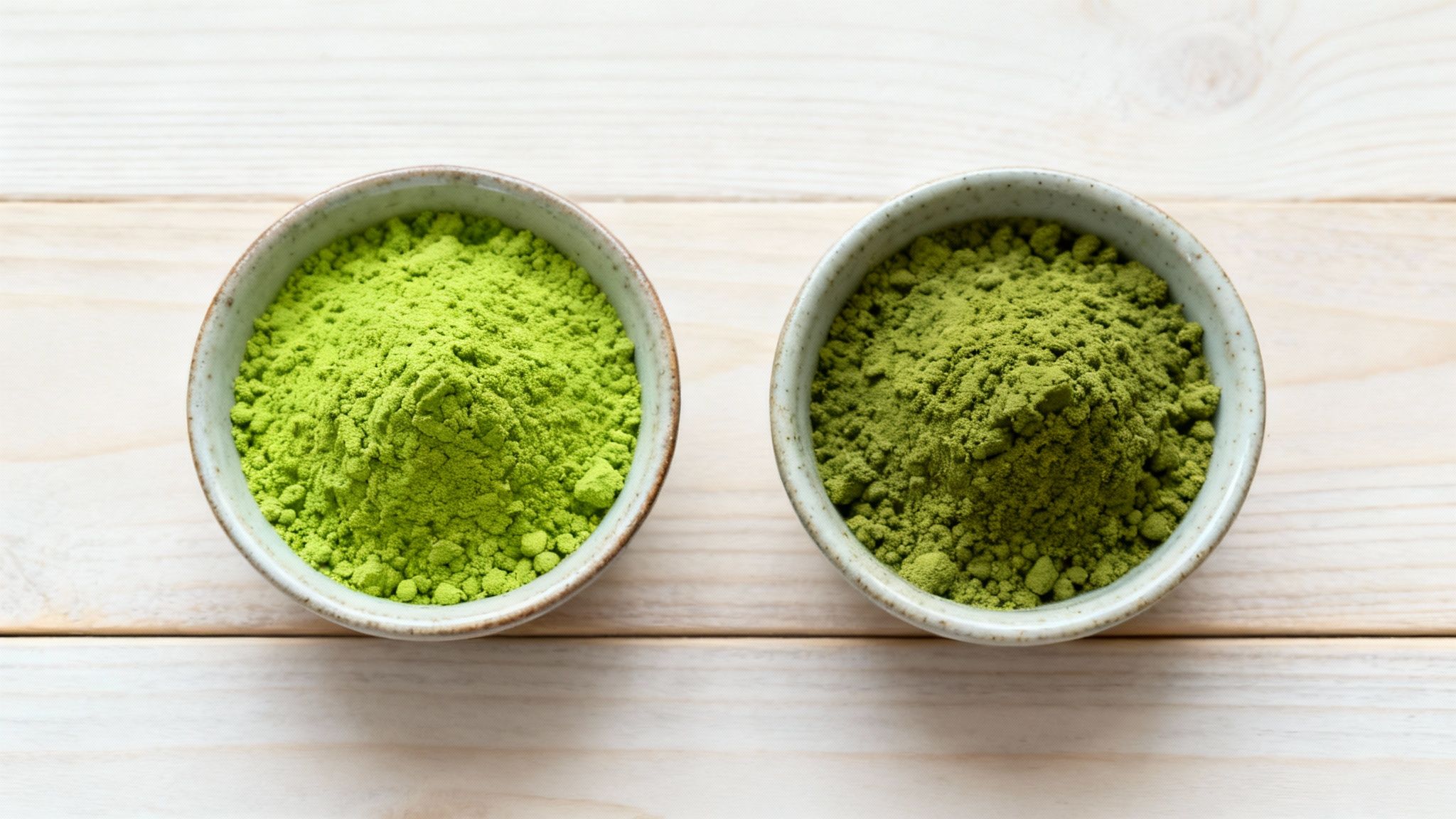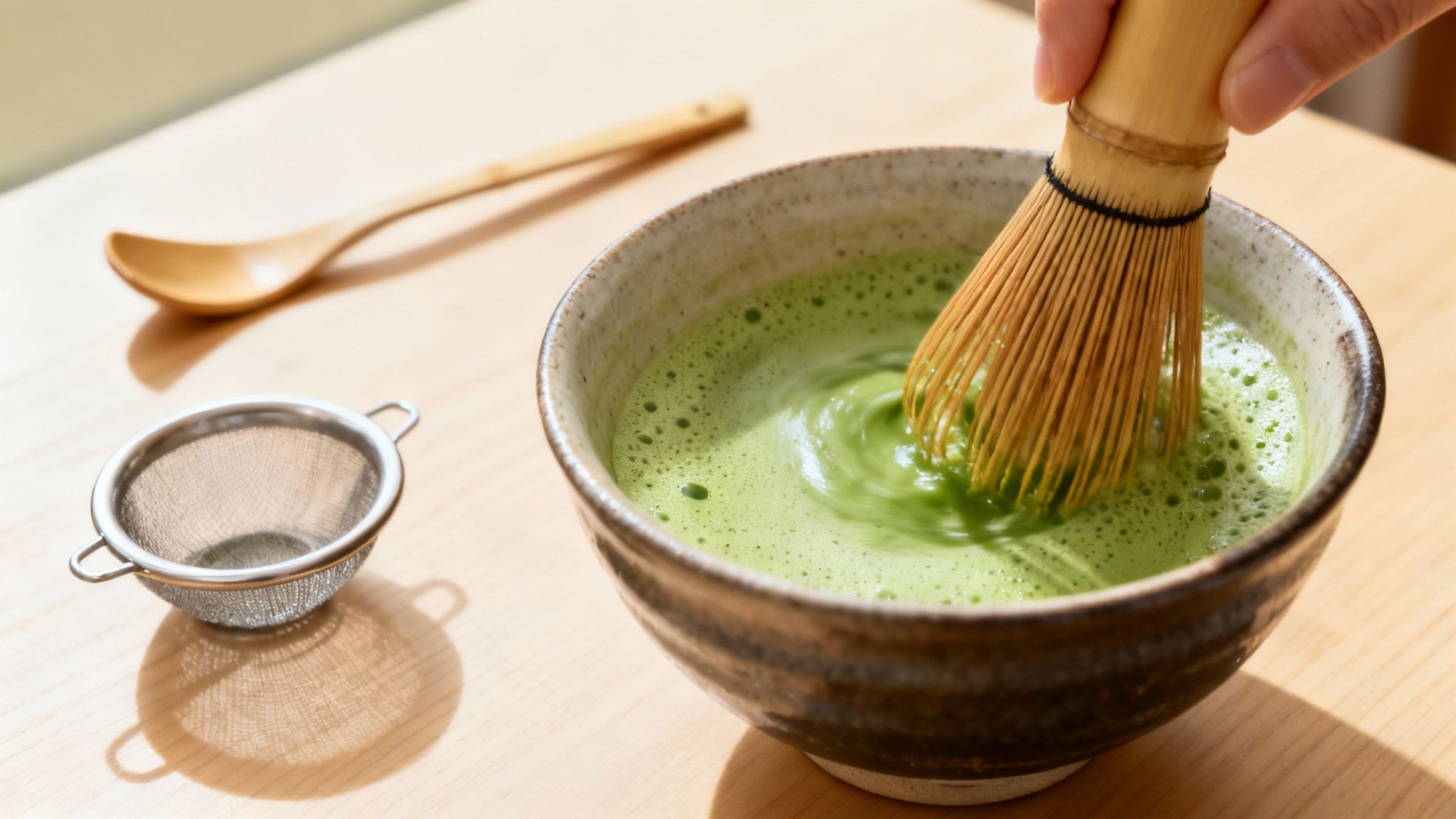Ever wondered what matcha powder really is? At its heart, the concept is beautifully simple: it's a very special kind of green tea where you enjoy the whole leaf, not just an infusion.
When you brew a regular cup of green tea, you’re steeping the leaves and then tossing them away. With matcha, the finely ground, stone-milled leaves are whisked directly into the water, meaning you drink every last bit of their concentrated goodness.
Unpacking the Essence of Matcha Powder

Think of it like this: you can get some nutrients from orange juice, but you get far more by eating the entire orange. That’s the core difference between your standard cuppa and a bowl of matcha. This 'whole food' philosophy is precisely why it packs such a punch in terms of flavour, vibrant emerald colour, and a much higher dose of nutrients.
Far from being a modern wellness fad, this vibrant powder is an ancient cornerstone of Japanese tea ceremonies, treasured for centuries. Its journey from a highly respected art form to a global café staple is a real testament to its unique charm. What truly sets it apart is its rich, savoury flavour – a taste known as umami – which offers a smooth, complex profile that’s both earthy and subtly sweet, without the sharp bitterness you might find in other green teas.
What Makes Matcha So Different?
The magic starts in the fields, long before any grinding takes place. The tea plants destined to become matcha are grown in the shade for about three weeks before being harvested. This crucial step forces the plant to overproduce chlorophyll and L-theanine, giving the final powder its famous deep green hue and wonderfully calming properties.
It's this unique combination of caffeine and L-theanine that creates a state of "calm alertness." You get a sustained lift of energy without the jitters or the dreaded crash often associated with a strong coffee. It’s no wonder it’s become the go-to for anyone seeking focus and a productive mindset.
"The magic of matcha lies in its synergy. You receive the energy from caffeine, beautifully balanced by the serene focus provided by L-theanine. It's an experience that nourishes both mind and body."
And people are catching on. The UK matcha tea market, for example, is set to grow significantly as more people seek out health-conscious, antioxidant-rich drinks. In fact, its value is expected to hit around USD 790 million by 2031.
Matcha Powder at a Glance
For anyone just dipping their toes into this green marvel, getting a quick overview of its core features is the best place to start. Here's a simple breakdown of what makes matcha, well, matcha.
| Attribute | Description |
|---|---|
| Origin | Traditionally from Japan, with regions like Uji in Kyoto being famous for producing the highest quality. |
| Taste Profile | Characterised by a rich, savoury "umami" flavour, with notes of sweetness and a creamy texture. |
| Preparation | Prepared by whisking the powder with hot (not boiling) water to create a frothy, uniform suspension. |
| Consumption | The entire tea leaf is consumed, which is why it's so different from other brews. |
This table gives you the essentials, but exploring the nuances is where the real fun begins.
Ultimately, understanding what matcha powder is means appreciating its incredible journey from a meticulously cultivated leaf to the versatile, nutrient-packed powder that has captivated the world. It stands in a class of its own, and if you're curious about what is the best green tea for you, understanding matcha is a fantastic starting point.
The Journey From Leaf to Powder

The real secret to matcha’s character isn’t just the leaf itself, but the centuries-old process that turns it into that vibrant powder. It’s a craft that’s part science, part art form, refined over generations to create something truly special.
This whole journey begins in the tranquil tea fields of Japan, where the Camellia sinensis plant is grown with one very specific outcome in mind. Long before the leaves are ever picked, they get some very special treatment that sets them apart from every other green tea out there.
The Art of Shading
About three to four weeks before the spring harvest, the tea fields undergo a dramatic transformation. The plants are carefully covered with dark cloths or traditional bamboo screens, which shield them from the sun's direct rays. This isn't just about protecting them; it's a clever technique to gently stress the plant.
When deprived of sunlight, the tea leaves have to work much harder to photosynthesise. This kicks two key compounds into overdrive. The first is chlorophyll, the pigment that gives plants their green colour – it’s why top-quality matcha has that incredible, almost glowing emerald hue.
The second is L-theanine, an amino acid that gives matcha its signature umami flavour and its famous ability to foster a feeling of calm, focused alertness.
The shading process is the single most important step in creating matcha's distinct profile. It elevates the leaf from a standard green tea into something far richer in both colour and calming amino acids, crafting a completely different sensory experience.
From Harvest to Tencha
Once the shading is done, only the youngest, most delicate leaves from the very top of the plant are picked by hand. This “first flush” harvest yields the most vibrant and nutrient-packed leaves, which are reserved for the highest grades of matcha.
Immediately after picking, the leaves are given a quick blast of steam. This crucial step lasts only about 15-20 seconds but it’s absolutely vital. It stops the oxidation process in its tracks, locking in the fresh flavour, bright green colour, and all those precious nutrients.
After a quick steam, the leaves are carefully dried in large, multi-chambered air machines. Then comes the most painstaking part: removing every single stem and vein from each leaf. It’s an incredibly laborious task, often still done by hand, that results in a pure leaf material known as tencha.
Think of tencha as the soul of the tea leaf, purified and ready for its final transformation.
The Final Grind
The last step in this intricate dance is to slowly and methodically grind the tencha into an ultra-fine powder. Traditionally, this is done with large, grooved granite stone mills that turn at a very slow pace. This deliberate speed is key, as it prevents friction from creating heat that would otherwise damage the tea’s delicate flavour and aroma.
It’s an unbelievably slow process. A single stone mill might only produce around 30-40 grams of matcha powder in an hour.
This slow grinding is what creates an exceptionally fine particle size, often just 5-10 microns—finer than a particle of smoke! It’s this silky, talc-like texture that allows the powder to suspend so perfectly in water, giving you that smooth, creamy consistency in a well-made bowl of matcha. Every single step is perfectly orchestrated to deliver the full spectrum of flavour, colour, and goodness that matcha is celebrated for.
Choosing Between Ceremonial and Culinary Grade

When you first dip your toes into the world of matcha, you quickly learn that not all green powders are the same. The biggest difference you need to get your head around is between Ceremonial Grade and Culinary Grade. Picking the right one is everything if you want the flavour and experience you’re hoping for.
Think of it like choosing olive oil. You’ve got your beautiful extra virgin olive oil for drizzling over a delicate salad, and then you have your everyday cooking oil. They both have their place, but using the wrong one can completely ruin a dish. The very same logic applies to matcha.
The Essence of Ceremonial Grade Matcha
Ceremonial Grade is the absolute best of the best—the pinnacle of matcha quality. It's crafted from the youngest, most delicate tea leaves picked during the year's very first harvest, known as the ichiban-cha.
These precious leaves are bursting with chlorophyll and L-theanine, which gives this grade its distinctive character:
- Vibrant Colour: An almost electric, deep emerald green that screams freshness and quality.
- Silky Texture: The powder is stone-ground to an unbelievably fine, talc-like powder that’s silky smooth.
- Delicate Flavour: It has a naturally sweet, creamy, and complex umami taste with almost zero bitterness.
This is the matcha reserved for the traditional Japanese tea ceremony, where it’s simply whisked with hot water and sipped on its own. It's the tea equivalent of a fine single-malt whisky—you enjoy it pure to appreciate all its subtle, nuanced flavours. Using it in a latte would be a real waste, as its delicate notes would get completely lost.
The Versatility of Culinary Grade Matcha
Culinary Grade, on the other hand, is the versatile workhorse of the matcha world. It's usually made from leaves picked in later harvests. These older leaves have a stronger, more robust flavour that’s a bit more astringent.
But that bolder taste is actually a huge plus. It’s designed to hold its own against other ingredients, making it the perfect choice for mixing into drinks and recipes. If you tried to bake with Ceremonial Grade, its gentle flavour would be completely steamrolled by the flour and sugar. Culinary Grade has the punch to cut through.
"Choosing the right grade is less about which is 'better' and more about what you want to do with it. Ceremonial is for savouring purity, while Culinary is for creative flavour infusion."
This versatility has helped matcha take over cafes and kitchens everywhere. The global matcha market was valued at a whopping USD 4.28 billion in 2024 and is set to keep growing, a trend we're definitely seeing here in the UK.
Ceremonial vs Culinary Grade Matcha
To help you see the difference at a glance, here’s a straightforward breakdown.
| Feature | Ceremonial Grade | Culinary Grade |
|---|---|---|
| Source | First harvest (ichiban-cha) leaves | Later harvest leaves |
| Colour | Vibrant, deep emerald green | Duller, often yellowish-green |
| Texture | Ultra-fine, silky powder | Coarser, slightly gritty texture |
| Flavour | Sweet, creamy, rich umami, no bitterness | Bold, slightly bitter, and astringent |
| Best For | Drinking straight with water (usucha or koicha) in traditional tea ceremonies | Lattes, smoothies, baking, ice cream, and other mixed recipes |
| Price Point | Premium | More affordable |
Ultimately, knowing which to buy comes down to one simple question: how are you going to use it?
- Choose Ceremonial Grade for: Traditional tea, where you’re drinking it with just hot water.
- Choose Culinary Grade for: Lattes, smoothies, ice cream, and baking. For some brilliant ideas, check out our guide to making fantastic matcha pancake recipes.
By matching the grade to your goal, you’ll make sure you get the best possible flavour, colour, and experience from your matcha every single time.
What Makes Matcha So Good For You?
Sure, matcha is known for its vivid green colour and uniquely savoury flavour, but it's also earned a serious reputation as a wellness powerhouse. This isn't just another passing health fad; the benefits are woven into the very way the tea is grown and prepared. When you drink matcha, you're consuming the entire tea leaf, which means you get a concentrated blast of nutrients that regular steeped tea just can't deliver.
At the heart of matcha's health benefits is its staggering antioxidant content. Think of antioxidants as your body's personal clean-up crew, working to neutralise nasty free radicals—those unstable molecules that can damage cells and contribute to ageing and illness.
Matcha is absolutely packed with a type of antioxidant called catechins. While all green teas have them, matcha is in a league of its own. The most celebrated of these is Epigallocatechin gallate (EGCG), a potent compound that scientists have been studying for its incredible protective effects.
The Powerhouse of Antioxidants and Calm Energy
Because you’re drinking the whole ground leaf, a single bowl of matcha can offer up to 137 times more EGCG than a standard cup of steeped green tea. That’s a massive dose of antioxidants to help your body defend itself against daily stress.
But the real magic of matcha lies in a rare amino acid called L-theanine, which becomes supercharged during the shading process. L-theanine is what gives matcha its famous ability to create a state of calm, focused alertness.
It works by boosting alpha wave activity in the brain—the same brainwaves you experience during meditation or moments of quiet creativity. This is precisely why a cup of matcha feels so different from other caffeinated drinks.
You know that jittery, on-edge feeling you can get from coffee, often followed by a crash? Matcha gives you something else entirely: a smooth, sustained energy lift. The L-theanine beautifully balances the natural caffeine, delivering clean, clear-headed focus without any of the anxiety.
This unique synergy makes matcha the perfect companion for a productive morning at work, a deep study session, or any time you need to be sharp and centred.
A Boost for Metabolism and Brain Function
The partnership between EGCG and caffeine is also thought to give your metabolism a gentle nudge. Some studies suggest they work together to increase thermogenesis—the rate your body burns calories—which can be a helpful addition to a healthy lifestyle.
And it doesn't stop there. That special combination of compounds is fantastic for your brain, too. L-theanine, caffeine, and EGCG each bring something to the table.
- L-theanine can cross the blood-brain barrier, helping to boost mood-regulating neurotransmitters like dopamine and serotonin.
- Caffeine, of course, is a well-known stimulant that sharpens focus and helps you feel more awake.
- EGCG chips in with its antioxidant power, helping to protect brain cells from damage over time.
Together, this trio works to enhance both your immediate focus and your long-term cognitive health. Choosing matcha isn't just about enjoying a delicious drink; it's a simple ritual that nourishes your body and mind with a rich array of compounds designed to help you thrive.
How to Prepare the Perfect Cup of Matcha

So, you’re ready to turn that vibrant green powder into an incredible drink? Fantastic. Making matcha is a mindful ritual that feels like both art and science, but you'll be pleased to know it's surprisingly easy to get the hang of.
Whether you're drawn to the classic Japanese tea ceremony or just fancy whipping up a quick café-style latte, getting the technique right is what makes all the difference. We’ll start with the traditional method, a practice honed over centuries to bring out the very best in your matcha. It’s the perfect way to appreciate the pure, unadulterated taste of a high-quality ceremonial grade.
The Traditional Ceremonial Method
At the heart of a traditional preparation are a few key tools. Of course, you can improvise, but for that perfect, velvety texture, the right equipment really helps.
- Chawan (Tea Bowl): A wide, flat-bottomed bowl that gives you plenty of room to whisk properly.
- Chasen (Bamboo Whisk): This is the star of the show. Its fine, flexible tines are expertly designed to aerate the tea and create a rich, stable foam.
- Chashaku (Bamboo Scoop): A simple, elegant scoop for measuring out the perfect amount of matcha.
Once you have your tools, the process is a simple, meditative series of steps. The goal isn't just to stir; it’s to create a smooth, frothy suspension.
The secret to a perfect bowl of matcha is aeration. The vigorous whisking doesn't just mix the tea; it whips air into the liquid, creating a delicate microfoam that softens the flavour and gives it a creamy, luxurious mouthfeel.
Follow these steps for a flawless cup every time:
- Warm Your Bowl: Pour a little hot water into your chawan to warm it. Tip the water out and dry the bowl thoroughly.
- Sift Your Matcha: This is a non-negotiable step! Use a fine-mesh sieve to sift 1-2 teaspoons of matcha powder into the bowl. It breaks up any clumps and guarantees a silky-smooth finish.
- Add Hot Water: Pour in about 60-70ml of hot water. The ideal temperature is around 80°C (175°F). Boiling water will scorch the delicate tea, leaving you with a bitter taste.
- Whisk Vigorously: Holding the chasen vertically, whisk the matcha rapidly in a 'W' or 'M' shape, not in circles. Keep going for about 20-30 seconds until a thick, jade-coloured froth with tiny bubbles covers the surface.
Using high-quality water is also crucial. You can learn more about the importance of filtered water for brewing hot beverages.
The Modern Matcha Latte
While the traditional ritual is beautiful, sometimes you just crave a creamy, comforting latte. This method is much more forgiving and works perfectly with Culinary Grade matcha.
Making a café-quality matcha latte at home is incredibly simple. Here in the UK, matcha's popularity has soared far beyond the teacup, popping up in lattes, smoothies, and even desserts. It has become a proper staple of modern café culture.
Here’s an easy recipe to get you started:
- Sift 1 teaspoon of culinary matcha into a mug.
- Add a splash of hot water (around 80°C) and whisk until smooth. A bamboo whisk is great, but a small electric milk frother also does the trick.
- Heat and froth 200ml of your favourite milk – oat, almond, or dairy all work wonderfully.
- Pour the frothed milk over your matcha paste. Sweeten with a little honey or maple syrup if you fancy it.
If you’re just starting your journey, our detailed guide on preparing matcha tea has even more tips and tricks to help you perfect your technique.
Your Matcha Questions, Answered
As you dip your toes into the world of matcha, a few questions are bound to pop up. It's not your average tea, and it certainly isn't coffee, so it’s only natural to be curious about what makes this vibrant green powder tick. Let's tackle some of the most common queries so you can get on with enjoying your new ritual.
We'll cover everything from its unique energy kick to its unmistakable flavour, helping you build a deeper appreciation for this ancient drink. Think of this as your friendly guide to navigating the wonderful world of matcha.
So, How Does its Caffeine Compare to Coffee?
This is usually the first question on everyone's lips: how does a bowl of matcha stack up against my morning flat white? A standard serving of matcha, which is about one teaspoon of powder, typically contains around 35-70 mg of caffeine. For comparison, an average cup of coffee can pack anywhere from 95-200 mg.
But looking at the numbers alone doesn't tell the whole story. The energy boost you get from matcha feels worlds away from a coffee buzz. The secret? An amino acid called L-theanine, which is found in abundance in shade-grown matcha leaves.
L-theanine is matcha's magic ingredient. It works together with the caffeine to create a state of calm, focused alertness. You can say goodbye to the sharp jolt and inevitable crash that coffee often brings. Instead, matcha offers a smooth, sustained wave of energy that can keep you going for hours.
Matcha's superpower is the beautiful partnership between its caffeine and L-theanine. This duo delivers a clean, jitter-free lift that sharpens your focus and boosts your mood, all without sending your system into overdrive. It's the perfect recipe for a clear-headed, productive morning.
Does Matcha Just Taste Like Green Tea?
If your only experience with green tea is the kind you find in a teabag, you're in for a surprise. While they both come from the same plant, the way matcha is grown and prepared results in a completely different flavour profile. They're not even in the same league.
Regular steeped green tea often has a light, grassy, and sometimes slightly bitter taste. A good matcha, on the other hand, is a far richer, more complex affair.
- A Savoury Umami Note: The hallmark of high-quality matcha is its deep, savoury umami flavour. It's an earthy, satisfying richness that coats your palate.
- A Creamy, Velvety Body: Because you're consuming the entire leaf ground into a fine powder, a properly whisked matcha has a wonderfully smooth, full-bodied texture. It’s far more substantial than a watery, steeped tea.
- A Hint of Natural Sweetness: The best matcha has a delicate, natural sweetness and none of the harsh bitterness you might find in lower-quality green teas.
Honestly, the experience is less like sipping a tea and more like savouring a rich, nourishing, and velvety broth.
Can I Drink Matcha Every Day?
Absolutely! In fact, weaving matcha into your daily routine is a fantastic way to consistently tap into its benefits. That unique blend of antioxidants, L-theanine, and gentle caffeine makes it a brilliant daily ritual for sharpening your focus and promoting an overall sense of wellbeing.
Of course, as with anything containing caffeine, it's all about balance. Most people find that 1-2 servings of matcha a day is the sweet spot. This lets you enjoy all the good stuff without going overboard on the caffeine. As always, the best advice is to listen to your body.
How Do I Keep My Matcha Powder Fresh?
This is a big one. Proper storage is the key to protecting matcha's bright green colour, delicate flavour, and powerful nutrients. There are three things matcha really doesn't like: light, air, and heat. Expose it to any of these, and it will quickly lose its vibrancy and turn bitter.
To keep your powder in peak condition, just follow these simple rules:
- Seal It Tight: Always store your matcha in an airtight container. The little tins it often comes in are perfect for the job.
- Keep It in the Dark: Pop the container in a cool, dark place like a cupboard or pantry, well away from any sunlight.
- Keep It Cool: For long-term storage, the fridge is your best friend for an unopened tin. Once opened, you can keep it in the fridge to prolong its freshness—just make sure the lid is sealed tightly to keep out moisture and any stray food smells.
Look after your matcha, and you'll make sure every single bowl is as fresh and flavourful as the first.
Ready to explore the world of authentic, high-quality matcha? Jeeves & Jericho sources premium ceremonial and culinary grades directly from Uji, Japan, ensuring every scoop delivers the vibrant flavour and smooth texture you deserve. Discover our full collection today.


